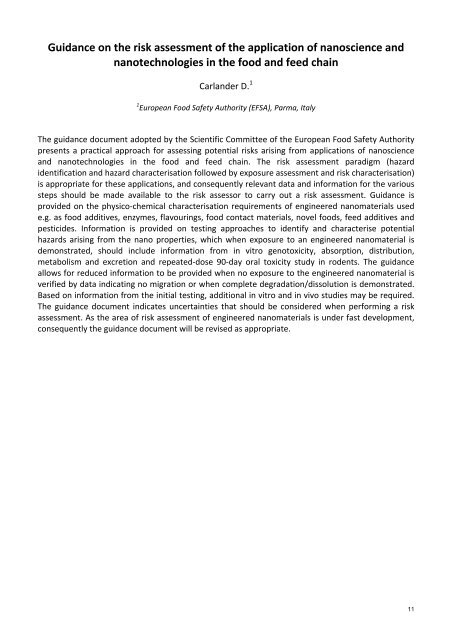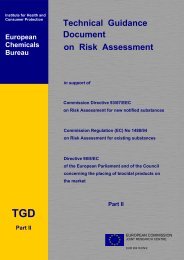Challenges of Regulation and Risk Assessment of Nanomaterials
Challenges of Regulation and Risk Assessment of Nanomaterials
Challenges of Regulation and Risk Assessment of Nanomaterials
Create successful ePaper yourself
Turn your PDF publications into a flip-book with our unique Google optimized e-Paper software.
Guidance on the risk assessment <strong>of</strong> the application <strong>of</strong> nanoscience <strong>and</strong><br />
nanotechnologies in the food <strong>and</strong> feed chain<br />
Carl<strong>and</strong>er D. 1<br />
1 European Food Safety Authority (EFSA), Parma, Italy<br />
The guidance document adopted by the Scientific Committee <strong>of</strong> the European Food Safety Authority<br />
presents a practical approach for assessing potential risks arising from applications <strong>of</strong> nanoscience<br />
<strong>and</strong> nanotechnologies in the food <strong>and</strong> feed chain. The risk assessment paradigm (hazard<br />
identification <strong>and</strong> hazard characterisation followed by exposure assessment <strong>and</strong> risk characterisation)<br />
is appropriate for these applications, <strong>and</strong> consequently relevant data <strong>and</strong> information for the various<br />
steps should be made available to the risk assessor to carry out a risk assessment. Guidance is<br />
provided on the physico-chemical characterisation requirements <strong>of</strong> engineered nanomaterials used<br />
e.g. as food additives, enzymes, flavourings, food contact materials, novel foods, feed additives <strong>and</strong><br />
pesticides. Information is provided on testing approaches to identify <strong>and</strong> characterise potential<br />
hazards arising from the nano properties, which when exposure to an engineered nanomaterial is<br />
demonstrated, should include information from in vitro genotoxicity, absorption, distribution,<br />
metabolism <strong>and</strong> excretion <strong>and</strong> repeated-dose 90-day oral toxicity study in rodents. The guidance<br />
allows for reduced information to be provided when no exposure to the engineered nanomaterial is<br />
verified by data indicating no migration or when complete degradation/dissolution is demonstrated.<br />
Based on information from the initial testing, additional in vitro <strong>and</strong> in vivo studies may be required.<br />
The guidance document indicates uncertainties that should be considered when performing a risk<br />
assessment. As the area <strong>of</strong> risk assessment <strong>of</strong> engineered nanomaterials is under fast development,<br />
consequently the guidance document will be revised as appropriate.<br />
11








